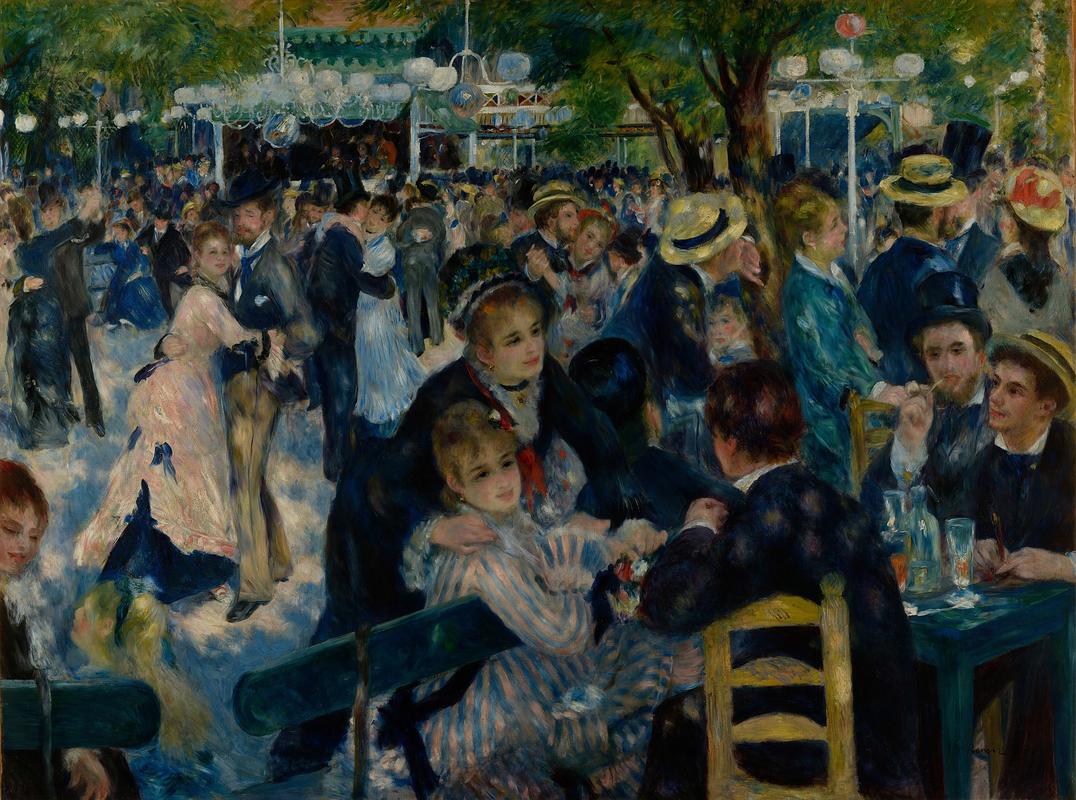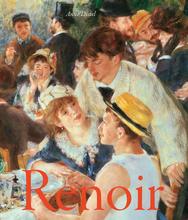More about Dance at Le Moulin de la Galette
- All
- Info
- Shop

Featured Contributor
The Moulin de la Galette was an open-air dance hall in the Montmartre district of Paris.
Open-air dance halls were very popular in 19th-century France as they provided great entertainment. Most people did not go there to dance but to watch the dancers and enjoy the relaxed atmosphere. Pierre-Auguste Renoir, who was a frequent visitor of the Moulin de la Galette, decided to bring his canvas in 1876 and paint this work which hangs nowadays in the Musée d’Orsay. Renoir was the only Impressionist artist who painted these open-air dances. He brought his canvas from his nearby studio more often to this dance hall, and when it was windy, his friends helped him keep the canvas straight while he was painting.
On the middle left, Renoir paints people dancing under the acacia trees and the hanging chandeliers. The dancing women are mainly local people, and the men are mostly friends of Renoir. The people on the table in the foreground are also friends of Renoir. These open-air dances were usually adult-only events, but on the bottom left, Renoir includes a child playing with her mother. It seems likely that he painted this work on a Sunday afternoon when the dance hall was open to families with children. Check the blog post on www.tripimprover.com for more details on the identity of some of the people in this painting.
Renoir used loose brush strokes in this work. As a result, the painting lacks quite some detail. When this painting was first shown to the public, viewers were confused and thought that Renoir had not finished his painting yet. However, Renoir understood that the human eye could fill in the details when viewing the painting. He did this more often, like in A Girl with a Watering Can where he purposely left out the effects of shadow. He rather focused on the effects of light and movement, and create a bright and happy painting of the public dance. Renoir was not fond of complicated and serious paintings. He rather painted simple, happy impressions from daily life. The Apple Seller is a great example of such a happy painting by Renoir.

Sr. Contributor
Renoir crashed the club to paint a ton of his friends mid-party.
The Moulin de la Galette was a mill at the top of the trendy Montmartre district where every young and fashionable Parisian would go to get hammered, gorge on artisan breads, and dance until they dropped. Renoir was the master of plein air painting at this point in his career. Which made prepping for the painting as simple as setting up his easel at the mill and telling all his buddies to get the gang together for a rager. The painting took three months to finish, with Renoir spending most of that time either at the mill or nearby in a makeshift studio for easy access to the dance floor to refresh the mind's eye.
Virtually everyone depicted is either a professional model or a fellow young painter. Case in point, the dancing couple to the left staring at the viewer is model Marguerite Legrand and the Cuban-Spaniard painter Don Pedro Vidal de Solares y Cárdenas. The painting specifically depicts Margot cheering up the super serious Spaniard by teaching him to polka and sing dirty ditties in French. She died two years later of typhoid, Renoir paying for her health care and funeral.
After all that work, critics and the public alike gave Dance the cold shoulder on its debut at the third Impressionist exhibition. Gustave Caillebotte, a photography obsessed fellow Impressionist, scooped up the painting for his private collection and in 1894 left it to the state. Dance then did the exhibition shuffle, moving from the Luxembourg Museum to the Louvre and to the d'Orsay, from which it now basically never leaves. People besides Caillebotte finally caught on to Renoir's genius after the painting hung in the Luxembourg, where it was seen and copied by the likes of Henri de Toulouse-Lautrec and Pablo Picasso.
Sources
- http://www.musee-orsay.fr/en/collections/works-in-focus/painting/commen…
- https://www.hermitagemuseum.org/wps/portal/hermitage/what-s-on/temp_exh…
- http://www.musee-orsay.fr/en/collections/index-of-works/notice.html?no_…
- https://books.google.com/books?id=e4drBgAAQBAJ&pg=PT86&lpg=PT86&dq=bal+…
- https://books.google.com/books?id=K5rwCwAAQBAJ&pg=PT56&dq=bal+du+moulin…
Featured Content
Here is what Wikipedia says about Bal du moulin de la Galette
Bal du moulin de la Galette (commonly known as Dance at Le moulin de la Galette) is an 1876 painting by French artist Pierre-Auguste Renoir.
It is housed at the Musée d'Orsay in Paris and is one of Impressionism's most celebrated masterpieces. The painting depicts a typical Sunday afternoon at the original Moulin de la Galette in the district of Montmartre in Paris. In the late 19th century, working-class Parisians would dress up and spend time there dancing, drinking, and eating galettes into the evening. Like other works of Renoir's early maturity, Bal du moulin de la Galette is a typically Impressionist snapshot of real life. It shows a richness of form, a fluidity of brush stroke, and a flickering, sun-dappled light.
From 1879-94 the painting was in the collection of the French painter Gustave Caillebotte; when he died it became the property of the French Republic as payment for death duties. From 1896-1929 the painting hung in the Musée du Luxembourg in Paris. From 1929 it hung in the Louvre until it was transferred to the Musée d'Orsay in 1986.
Check out the full Wikipedia article about Bal du moulin de la Galette















